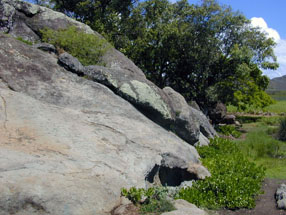
- INTRODUCTION
- Geology
- Seasons
- RESTORATION
- SUCCESSION
What is unique about Nā Pōhaku o Hauwahine?
Native plant restoration at Nā Pōhaku ![]() CLICK HERE
CLICK HERE

• Base of the main rock
along edge of Kawai Nui Marsh.
INTRODUCTION
 |
|
||||
|
|||||
| There are not many places in the lowlands of O‘ahu where you can find sizable boulder formations. By sizable, I mean worn, massive boulders from a couple of yards to over 30 feet across. Not that rocks are uncommon: there are talus slopes of rocks broken off the lava on steep eroded slopes and, of course, rocky shorelines scattered around the coast of the Island. Still, the rocks at Nā Pōhaku o Hauwahine are unusual (and pōhaku is rock in Hawaiian, nā, making it into the plural). The reason is that these rocks are from lava flows that pooled. Instead of flowing downslope to create bedded flows of the sort that compose the bulk of the Hawaiian Islands, the erupting magma that formed the rocks here collected in a basin. The lava solidified in a crater or depression probably resembling Halema‘uma‘u fire pit on Kilauea (Island of Hawai‘i).<1> Nā Pōhaku o Hauwahine is located within the caldera part of the ancient Ko‘olau volcano, so comparison with Halemaumau is very apt, since the latter is a conspicuous feature of the active Kilauaea caldera.
Native plant restoration at Nā Pōhaku
|

• Base of the main rock
| ||||
|
PAGE NOTES: Note <1> – The Hawaiian Islands represent a chain of increasing island age from Hawai‘i to Kaua‘i. We can see in the geology and form of the "Big Island," what Kaua‘i or O‘ahu looked like millions of years in the past, and in these older islands, what Hawai‘i will look like a few million years in the future. The age of the Ko‘olau Volcano (east O‘ahu), and thus the time passed since these rocks at Nā Pōhaku were newly erupted magma, is around 2 million years. Page last modified: April 25, 2011 by Webmaster (webguy@aecos.com). © 2010-2011. Eric B. Guinther ~ All rights reserved.
|